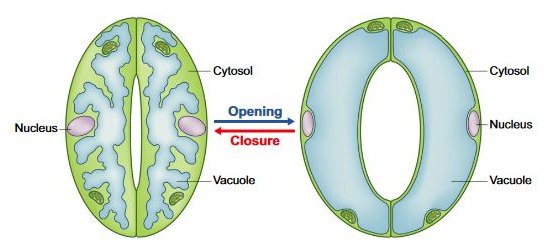Vacuoles are compartments delimited by a membrane and filled with water and ions. They play a crucial role in regulating the cellular turgor pressure of plants. This internship will reproduce in-silico vacuole networks.

Context :
Vacuoles, which are compartments delimited by a membrane and filled with water and ions, are present in the cells of plants, fungi, and some animals. In plants, the vacuoles occupy the major part of the cellular volume, and plays a crucial role in regulating the cellular turgor pressure. The swelling of vacuoles has thus been shown as being concomitant of, and often causing, the movement of some plant cells, such as guard cells in stomata.
Stomata control fluxes of gas (CO2 and vap-H2O) between a plant and its environment (fig. 1) ; it was shown from long that their opening and closure are linked to the reversible swelling of the vacuoles in the two guard cells which surround the stomata pore (figure 2). However, the mechanics of the phenomenon is not fully understood, and appears as counter-intuitive : how comes that the inflation of such a structure facilitates the creation of a passage instead of blocking it ?
Recent 3D data on Arabidopsis (figure 3) provide details on the vacuoles' structure, that could be of importance to understand the forces at stake in this conformation change.
Trainee's work :
In the framework of the AFM and confocal data obtained in IPSiM (Institut des Sciences des Plantes de Montpellier), the vacuoles will be modelled, using the software Surface Evolver, as elastic containers, to be swollen (through volume increase) with a known pressure. The cell plant wall will be modelled as a constraint, enabling the measurement of local forces.
The goal of the internship is to undercover and identify the specificities of the geometry, and possibly the topology, of the network of vacuoles making possible the control of an aperture, in a way compatible with biologic features.
Skills requirements :
The objective of the internship will be to reproduce an in-silico vacuole network that allows an efficient opening of the stomata, and to optimize it by a constant comparison between simulations and experimental results.
Basic knowledge in life sciences and spatial vision would be a plus, as well as a taste for observation, mechanics of continuous media, architectural thinking... and implementation. Technical knowledge in coding not required. Imagination and enthusiasm welcome.
References :
[1] Connecting vacuolar and plasma membrane transport networks, Paloma Cubero-Fontand & Alexis De Angeli, New Phytologist(2021)229:755–762 [2] Stomatal opening involves polar, not radial, stiffening of guard cells, Carter et al., 2017, Current Biology 27, 2974–2983 [3] Numerical deflation of beach balls with various Poisson's ratios, C. Quilliet, EPJE (2012) 35, 48

